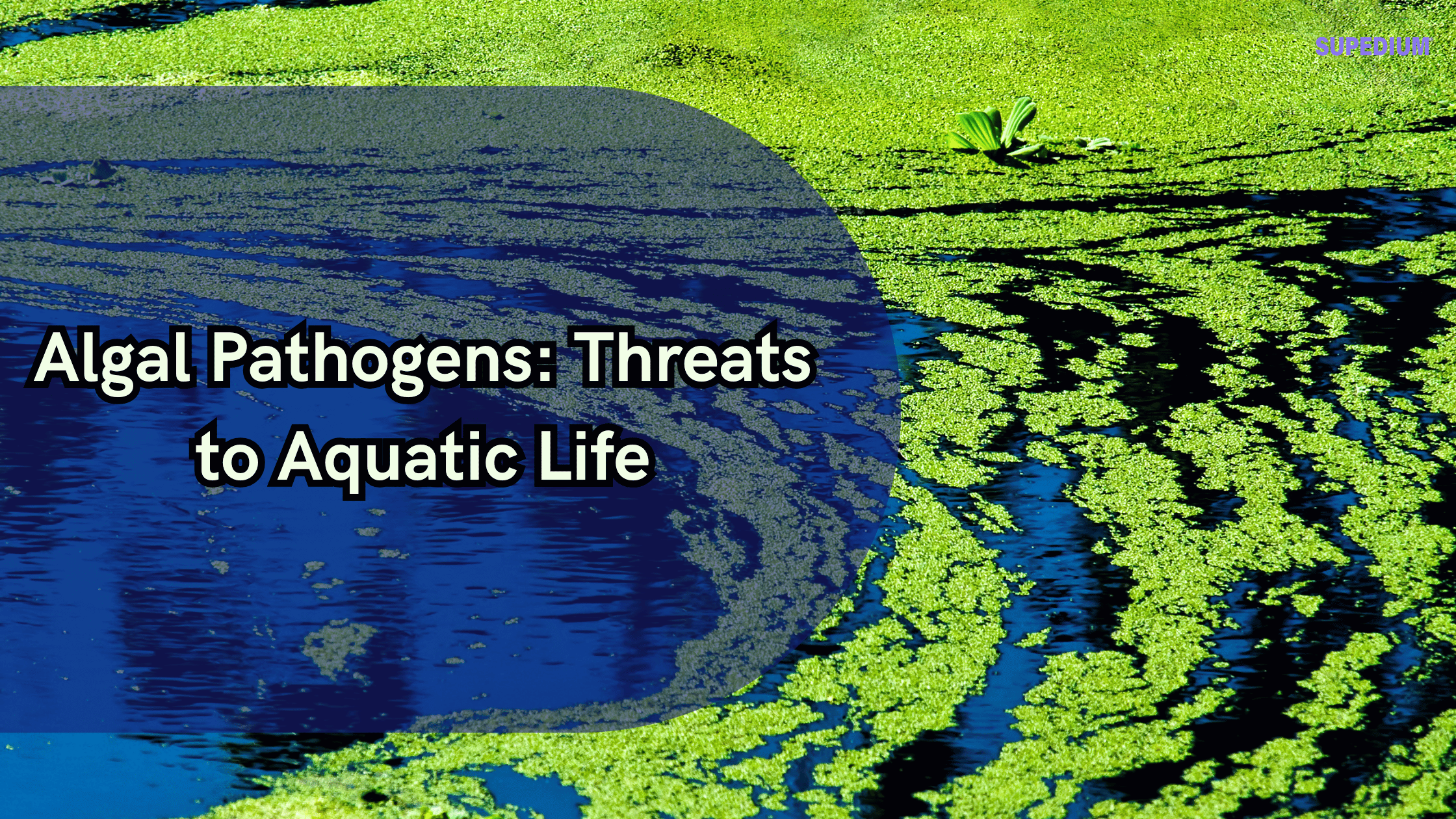Table of Contents
![]()
Algal pathogens are emerging as significant threats to aquatic ecosystems, causing environmental, economic, and public health concerns. As climate change and human activity continue to affect water quality, harmful algal blooms (HABs) and the pathogens associated with them are becoming more prevalent. These pathogens have far-reaching consequences for aquatic life, the surrounding environment, and even human health. This article will explore the nature of algal pathogens, their impact on aquatic life, the pathways through which they affect ecosystems, and the strategies being employed to mitigate their effects.
Understanding Algal Pathogens
What are Algal Pathogens?
Algal pathogens are species of algae that, under certain conditions, become harmful to aquatic ecosystems. These species can produce toxins, outcompete other organisms for resources, or disrupt the natural balance of the ecosystem. While algae are a natural and essential part of the aquatic food chain, certain types can become harmful under conditions like nutrient overload, increased water temperatures, and stagnant water.
Some of the most well-known algal pathogens are cyanobacteria (often called blue-green algae), dinoflagellates, and certain diatoms. These species thrive in environments with high nutrient levels, typically from agricultural runoff or wastewater discharges, making them a growing concern in both freshwater and marine systems.
Types of Algal Pathogens
- Cyanobacteria: These are among the most common and concerning algal pathogens. Certain strains, such as Microcystis and Anabaena, produce potent toxins that can contaminate drinking water supplies and harm fish and other aquatic life.
- Dinoflagellates: These single-celled organisms can cause harmful blooms known as “red tides,” producing neurotoxins that affect marine life, including fish, shellfish, and even humans.
- Diatoms: While typically not as toxic as cyanobacteria or dinoflagellates, some diatoms can still cause ecological disturbances by altering water chemistry and competing with native species for resources.
- Other less common species: Other types of algae, such as certain green and brown algae, can also become harmful under the right conditions, although they are less often implicated in toxic blooms.
Conditions Favoring the Growth of Algal Pathogens
Algal pathogens thrive under specific environmental conditions, including:
- Nutrient pollution (eutrophication): Excess nutrients, particularly nitrogen and phosphorus from agricultural runoff, wastewater, and industrial discharges, stimulate algal growth, leading to harmful blooms.
- Warming water temperatures: As water temperatures rise due to climate change, conditions become more favorable for many types of harmful algae, particularly cyanobacteria and dinoflagellates.
- Stagnant or slow-moving water: Algae often proliferate in water bodies that lack strong currents, such as lakes, reservoirs, and slow-moving rivers, where toxins can accumulate and pose risks to aquatic life and human health.
Effects of Algal Pathogens on Aquatic Life
Impact on Aquatic Organisms
Algal pathogens affect a wide range of aquatic organisms, from microscopic plankton to large fish species, as well as aquatic plants and invertebrates.
- Fish and Invertebrates: The toxins produced by some algae, like Microcystis and Karenia brevis, can cause direct poisoning to fish and invertebrates. Additionally, the decomposition of algal blooms can deplete oxygen levels in the water, creating “dead zones” where marine life suffocates. Fish kills are often the most visible and dramatic sign of an algal bloom.
- Aquatic Plants: Algal blooms can block sunlight from penetrating the water surface, preventing aquatic plants from performing photosynthesis. This reduction in plant life can destabilize entire ecosystems, as plants are crucial for oxygen production and providing food for herbivores.
- Microbial Communities: Algal blooms can disrupt the natural balance of microorganisms in the water. When algae die and decompose, they consume oxygen, creating hypoxic conditions that harm beneficial bacteria and other microorganisms vital to the food web.
Ecological Consequences
The ecological effects of algal pathogens are profound and can lead to long-term environmental changes, including:
- Altered biodiversity: Harmful algal blooms can reduce the diversity of aquatic species by creating conditions that favor only certain types of organisms, typically algae. This results in a shift in the composition of the ecosystem.
- Ecosystem shifts: In the worst cases, algal blooms can permanently alter ecosystems by disrupting the food chain and eliminating key species. For example, a shift from a fish-dominated to an algae-dominated system can have cascading effects throughout the ecosystem.
- Long-term environmental degradation: Prolonged algal blooms can degrade water quality and disrupt ecosystem services like water filtration, which can impact both natural systems and human communities that rely on clean water.
Pathways of Human and Ecological Impact
Economic Effects
The impact of algal pathogens is not limited to ecosystems; they also have significant economic consequences:
- Loss of fishery resources: Algal blooms can cause fish kills and reduce the productivity of aquatic ecosystems, leading to losses in commercial and recreational fisheries.
- Impact on tourism and recreation: Harmful algal blooms often turn water bodies into unsightly and unsafe places for recreational activities like swimming, boating, and fishing. This can deter tourists and result in financial losses for communities dependent on these industries.
- Costs of water treatment and management: Algal toxins can contaminate drinking water supplies, requiring expensive treatment measures to remove toxins and restore water quality.
Human Health Risks
Algal pathogens pose direct and indirect threats to human health:
- Toxicity in drinking water: Cyanobacterial toxins, such as microcystins, can contaminate drinking water sources, leading to a variety of health issues, including liver damage and gastrointestinal illnesses.
- Respiratory and skin issues: People exposed to harmful algal blooms through swimming or recreational activities can experience respiratory problems, rashes, and eye irritation.
- Contamination of food sources: Shellfish can accumulate toxins from dinoflagellate blooms, leading to shellfish poisoning in humans who consume contaminated seafood.
Climate Change and Algal Pathogens
Climate change is exacerbating the problem of algal pathogens. Rising temperatures, altered rainfall patterns, and increased frequency of extreme weather events contribute to the growth of harmful algal blooms:
- Rising water temperatures: Warmer waters are more conducive to algal growth, particularly for species like cyanobacteria and dinoflagellates.
- Altered precipitation patterns and nutrient runoff: Increased rainfall and storm intensity can lead to greater nutrient runoff into water bodies, further fueling algal growth and the spread of pathogens.
Case Studies of Algal Pathogen Events
Harmful Algal Blooms Worldwide
Harmful algal blooms are a global phenomenon, with significant ecological and public health impacts. Some notable examples include:
- Florida red tides: Caused by the dinoflagellate Karenia brevis, red tides are infamous for their devastating effects on marine life and coastal economies. These blooms produce toxins that can lead to mass fish kills and respiratory issues in humans.
- Microcystin-producing cyanobacterial blooms: In freshwater systems, cyanobacteria such as Microcystis have been responsible for toxic blooms that contaminate drinking water supplies, such as the 2014 Toledo water crisis.
- Dinoflagellate blooms: Coastal areas worldwide experience seasonal outbreaks of dinoflagellates, which can lead to paralytic shellfish poisoning in humans who consume contaminated shellfish.
The 2014 Toledo Water Crisis
The Toledo water crisis serves as a poignant reminder of the risks posed by algal pathogens. In 2014, a massive cyanobacterial bloom in Lake Erie caused the contamination of the city’s drinking water supply with microcystins. More than 400,000 residents were affected, highlighting the urgent need for effective monitoring and management of water bodies.
Prevention and Mitigation Strategies
Monitoring and Early Detection
Effective monitoring is crucial for managing algal blooms. Advances in remote sensing technologies and satellite imagery are helping scientists detect blooms early, allowing for more timely interventions.
Reducing Nutrient Pollution
One of the most effective ways to prevent algal blooms is to reduce the amount of nutrients entering water bodies:
- Wastewater treatment improvements: Upgrading wastewater treatment facilities to remove more nutrients from sewage can reduce the nutrient load in water bodies.
- Agricultural runoff management: Implementing best practices in farming, such as using fewer fertilizers and creating buffer zones along waterways, can significantly reduce nutrient pollution.
Water Body Management
Strategies such as controlling water flow and circulation in affected areas, managing aquatic vegetation, and using algicides can help mitigate the impact of algal blooms. However, these measures are often temporary and require careful consideration of long-term ecological impacts.
Public Education and Policy Development
Public awareness campaigns about the dangers of algal pathogens, along with stricter regulations on water quality, can help reduce the risk of future blooms. Governments and organizations must invest in research and policies to safeguard water resources and public health.
Conclusion
Algal pathogens are a growing threat to aquatic ecosystems, with far-reaching consequences for biodiversity, human health, and local economies. As climate change and human activities continue to exacerbate the problem, it is essential to implement effective monitoring, prevention, and management strategies. By reducing nutrient pollution, improving water management, and fostering global collaboration, we can mitigate the impact of harmful algal blooms and protect the health of aquatic life and the communities that depend on these ecosystems.
Share This





Be the first to comment